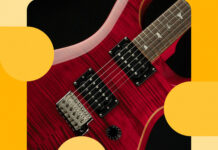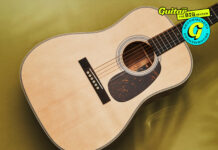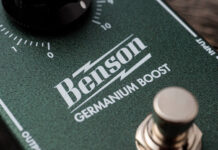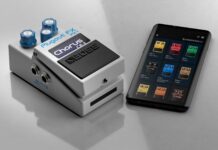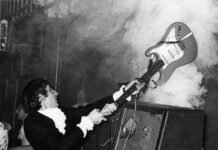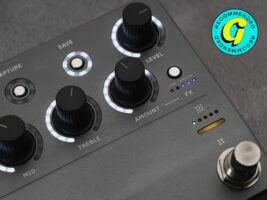
Neural DSP Nano Cortex review: NanOS 2.0 update – “Neural’s compact pedal becomes a true all-in-one multi-effects”
It’s probably fair to say that Neural DSP would have liked the launch of the Nano Cortex to go a bit better than it did. On the back of a teasing marketing campaign months in the making, there was huge excitement and expectation for Neural’s second-ever hardware product. After all, the Quad Cortex had quite literally reshaped the landscape of modern guitar with its easy usability, impressive sonic fidelity and thriving online community.
READ MORE: TC Electronic Ditto 2 review: “The easiest to use looper on the market just got even better”
When the NC finally dropped in September, however, the backlash was swift as it was brutal. Despite being very well reviewed across the board (including here on Guitar.com) there was much grumbling from Neural’s fanbase, who had already been riled up by some admittedly bizarre teaser videos, and felt the Nano Cortex had not lived up to the expectations and left them feeling short-changed.
Neural’s CEO Doug Castro later admitted that they were disappointed that people hadn’t seen the funny side of the teaser videos, and told us they’d been surprised by the backlash to the Nano Cortex at launch.
For what it’s worth, I thought a lot of the vitriol was a bit overdone. A lot of the criticism that was being levelled at the Nano Cortex, was because it wasn’t a QC-flavoured version of the Line 6 HX Stomp, or the IK Multimedia Tonex Pedal, but Neural had never claimed the Nano Cortex was trying to be that. You can argue, perhaps, that Neural’s deliberately mysterious marketing strategy – combined with the hype surrounding the Quad – created a void into which fans poured their hopes, dreams and speculations without any real basis in fact… but that’s hardly Doug Castro and co’s fault is it?
Image: Adam Gasson
Taken on its own merits, I still thought the original Nano Cortex was a fantastic and great value point of entry into the world of Neural’s fantastic ecosystem, and had real-world utility as an ‘end of the board’ pedalboard amp, even if the original OS’s lack of effects and tweakability limited its use as a standalone box in the way that the HX Stomp or the original Quad Cortex could be.
But the thing with Neural is, they’re never resting on their laurels for long. As Jason Mays alluded to in our original NC review, Neural DSP has a great track record for improving its products with software updates – they’ve hugely improved the QC since launch – and it was a fair bet that, as he put it, “you can bet that this already great product is going to keep getting better in the months and years to come”.
Enter then, NanOS 2.0 – the first substantive software update to the Nano Cortex, and one that on the surface seems to rectify almost every complaint people had about the product at launch… but have they delivered?
Nano Cortex NanOS 2.0 – what’s changed?
Much of the opprobrium levelled at the original Nano Cortex centred on the decision to include a fixed signal chain with a threadbare selection of onboard effects. NanOS 2.0 deals with this issue somewhat by adding a whopping 47 new effects and utility options to the mix.
The biggest gripe with 1.0 was the complete lack of any kind of dirt pedal options – especially given that the single capture slot in the Nano’s signal chain meant that you were unable to take advantage of the full gamut of Neural’s wonderfully broad and deep selection of drive pedal captures without sacrificing an amp in your chain… which rather defeated the purpose of the whole thing.
NanOS 2.0 adds nine new guitar drive pedals to the mix – but drive is the key word here. With the exception of one fuzz (a take on a classic Fuzz Face) the choices here are staunchly at the lower gain end of the market (plus a pair of Xotic-inspired clean boosts) – a Tube Screamer, a Blues Driver, an OCD, etc. The only thing that could be classed as hairy is the take on a RAT – no heavy distortion here. While you’ll find plenty of heaviness in the Cortex Cloud by way of amp captures, it’s a definite blow for the HM-2 crowd, and indeed anyone who likes to put a bit of pedal-based filth ahead of their amp as a matter of course.
Neural DSP Nano Cortext NanOS 2.0 screengrab
What you can now do, excitingly, is gain stack – because in addition to adding some effects, NanOS 2.0 has also added a fair bit more flexibility into the signal chain. By moving the noise gate into its own dedicated pre-capture slot in the chain, we now have two slots before the amp that can be used to run any of the onboard EQ, wah/filter, drive or compressor sounds – that means if you want to run your virtual TS- 808 into your fictional OCD before it hits that Dumble capture you like so much, you can do it.
The three post-capture slots offer more sounds – six new modulations, five new delays and five new reverbs – but the chain here is still fixed. You can swap out any of the three modules for a post-capture compressor or EQ if you so desire, but the order of modulation, delay and reverb is not flexible. Bizarrely, despite adding six new options to the mod slot, none of them is a tremolo… who needs four different choruses but no tremolo, really?
Other additions to the recipe are the ability to use bass captures at last, as well as the addition of some bass-specific effects (two drives and two wahs), and the handy ability to globally bypass the IR Loader. Previously, you had to manually turn off the Cab/IR setting in each preset if you wanted to use it with a real-life cab, which was an absolute pain in the arse if you wanted to switch between gigging mode and home practice mode on the reg.
Nano Cortex NanOS 2.0 – sounds and usability
Given that the headline addition for NanOS 2.0 is that bevvy of new drive pedals, it seems like dirt is the logical place to start. The extensive experience Neural has when it comes to crafting high-end digital guitar sounds is in evident across the various circuits on offer – the Tube Screamer has a noticeably different sonic character to the Blues Driver or the the OD-250, and they do a very fine job of capturing not just the sound but the feel of these pedals too. What’s more, they play together nicely too – sticking a TS in front of your Rat will add just the right amount of oomph and clarity, for example – and you can have fun gain-stacking these up in various combinations.
As a rule, fuzz pedals are a modeller’s worst enemy and it’s perhaps notable that Neural has only included one option here – it sounds fine in the way that most digital fuzz sounds get you 90% of the way there, but it still lacks that 10% untamed analogue unpredictability that makes real fuzz pedals so much fun.
Elsewhere, the ‘eight new compressors’ boast is a little misleading. There are four to choose from – a classic 1176, optical, VCA and SSL Bus – but you can choose between mono or stereo versions. The monos sit in the pre-capture slot, while the stereos can slot in anywhere in the post-capture chain.
Speaking of the post-capture chain, the expansion of the time and modulation-based effects is welcome. The four chorus options are deep and lush, with the spacey dream a particular highlight, while the various flavours of MXR-derived sound (Phase 90, flanger and Uni-Vibe) are suitably undulating and fun… still would have been nice to have a tremolo, mind.
The stereo delays are lots of fun if you’re running into a FRFR stereo cab or headphones, and they offer a nice balance of classics and some weirdness (dual reverse stereo delay, hello!) into the mix.
It’s the same story with the reverbs, though it’s a bit weird there isn’t just one labelled ‘Spring’ from seven options here, but you can jerry-rig a passable spring effect on the ambience setting, but c’mon guys what are we doing here?
You are still limited in that signal chain however – so there’s no chance to do something crazy like stick a dirt pedal after your reverbs or even stick your delay after your chorus or whathaveyou. That’s probably gonna annoy a very small subsection of players who like to do arcane things with their pedal order, but most of us are probably fine with the accepted way of doing things.
Nano Cortex NanOS 2.0 – does this make me want to buy one?
The quality of Neural’s onboard effects has never been an issue before, except by their absence, and there’s no doubt that NanOS 2.0 massively improves the potential of this to be an all-in-one box for gigging and recording. Even though the selection is still limited compared to the Quad Cortex, it still covers most bases and does an excellent job doing so.
The dirt pedals offer more of a challenge, because by and large most people using a QC up until this point have probably barely thought to explore Neural’s own sounds because of how easy it is to either capture your own pedal, or download any one of the hundreds of options available on the Cortex Cloud.
The pedals emulated here do a very good job of replicating the sounds they’re going after, but it’s hard not to feel a little short-changed when you consider the bountiful options presented in the app itself.
Neural DSP Nano Cortext NanOS 2.0 screengrab
For example, the first thing I saw this morning when I opened up Cortex Cloud to finish off this review were a handful of captures of JHS’s newly released Notadumble DIY pedal. “Oh that’d be fun” I momentarily thought to myself… before realising that such things are not for me.
There are currently nearly 15,000 different gain pedal captures on Cortex Cloud – in fact there are more pedal captures than there are amp captures – and the singular downside of the Nano Cortex is the FOMO you get from realising this fact.
At this point you have to assume that the inability to add a pedal capture slot into the NanOS signal chain in front of an amp capture is a hardware limitation rather than a software one – it’s pretty much the only thing keeping me from giving the Nano Cortex a perfect score, and they must realise this better than anyone.
Saying that, for a while there lots of users assumed the same thing about plugins and Quad Cortex, and Neural got there in the end – it just took a bit of time. If they can pull off the same trick with the Nano Cortex, it really would be unbeatable.
Neural DSP Nano Cortex alternatives
The IK Multimedia Tonex Pedal ($399/£299) has been the Nano’s biggest rival since launch, and it’s hard not to look at NanOS 2.0 as a direct response to it – and in that regard it’s certainly risen to the challenge. The Line 6 HX Stomp ($649/£549) is the other direct rival to the NC, and while the Helix platform is getting a little long in the tooth now, it remains a hugely comprehensive compact amp and multi-effects pedalboard modeller with top-notch sounds – it lacks the capture facility and resultant community that Neural and IK can boast however.
The post Neural DSP Nano Cortex review: NanOS 2.0 update – “Neural’s compact pedal becomes a true all-in-one multi-effects” appeared first on Guitar.com | All Things Guitar.
Source: www.guitar-bass.net


